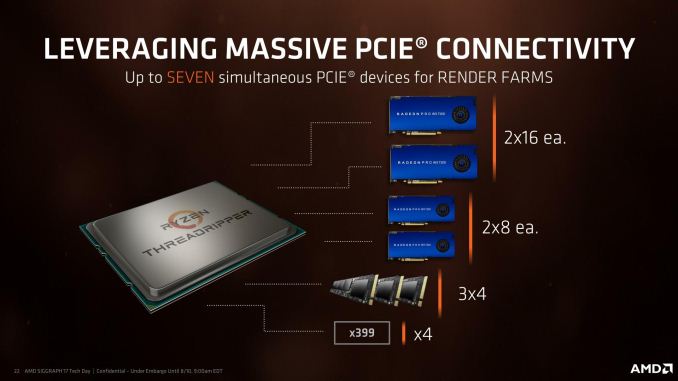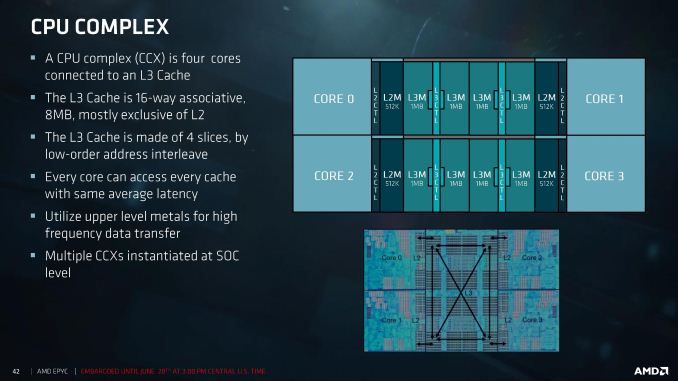The AMD Ryzen Threadripper 1950X and 1920X Review: CPUs on Steroids
by Ian Cutress on August 10, 2017 9:00 AM ESTFeeding the Beast
When frequency was all that mattered for CPUs, the main problem became efficiency, thermal performance, and yields: the higher the frequency was pushed, the more voltage needed, the further outside the peak efficiency window the CPU was, and the more power it consumed per unit work. For the CPU that was to sit at the top of the product stack as the performance halo part, it didn’t particularly matter – until the chip hit 90C+ on a regular basis.
Now with the Core Wars, the challenges are different. When there was only one core, making data available to that core through caches and DRAM was a relatively easy task. With 6, 8, 10, 12 and 16 cores, a major bottleneck suddenly becomes the ability to make sure each core has enough data to work continuously, rather than waiting at idle for data to get through. This is not an easy task: each processor now needs a fast way of communicating to each other core, and to the main memory. This is known within the industry as feeding the beast.
Top Trumps: 60 PCIe Lanes vs 44 PCIe lanes
After playing the underdog for so long, AMD has been pushing the specifications of its new processors as one of the big selling points (among others). Whereas Ryzen 7 only had 16 PCIe lanes, competing in part against CPUs from Intel that had 28/44 PCIe lanes, Threadripper will have access to 60 lanes for PCIe add-in cards. In some places this might be referred to as 64 lanes, however four of those lanes are reserved for the X399 chipset. At $799 and $999, this competes against the 44 PCIe lanes on Intel’s Core i9-7900X at $999.
The goal of having so many PCIe lanes is to support the sort of market these processors are addressing: high-performance prosumers. These are users that run multiple GPUs, multiple PCIe storage devices, need high-end networking, high-end storage, and as many other features as you can fit through PCIe. The end result is that we are likely to see motherboards earmark 32 or 48 of these lanes for PCIe slots (x16/x16, x8/x8/x8/x8, x16/x16/x16, x16/x8/x16/x8), followed by a two or three for PCIe 3.0 x4 storage via U.2 drives or M.2 drives, then faster Ethernet (5 Gbit, 10 Gbit). AMD allows each of the PCIe root complexes on the CPU, which are x16 each, to be bifurcated down to x1 as needed, for a maximum of 7 devices. The 4 PCIe lanes going to the chipset will also support several PCIe 3.0 and PCIe 2.0 lanes for SATA or USB controllers.
Intel’s strategy is different, allowing 44 lanes into x16/x16/x8 (40 lanes) or x16/x8/x16/x8 (40 lanes) or x16/x16 to x8/x8/x8x8 (32 lanes) with 4-12 lanes left over for PCIe storage or faster Ethernet controllers or Thunderbolt 3. The Skylake-X chipset then has an additional 24 PCIe lanes for SATA controllers, gigabit Ethernet controllers, SATA controllers and USB controllers.
Top Trumps: DRAM and ECC
One of Intel’s common product segmentations is that if a customer wants a high core count processor with ECC memory, they have to buy a Xeon. Typically Xeons will support a fixed memory speed depending on the number of channels populated (1 DIMM per channel at DDR4-2666, 2 DIMMs per channel at DDR4-2400), as well as ECC and RDIMM technologies. However, the consumer HEDT platforms for Broadwell-E and Skylake-X will not support these and use UDIMM Non-ECC only.
AMD is supporting ECC on their Threadripper processors, giving customers sixteen cores with ECC. However, these have to be UDIMMs only, but do support DRAM overclocking in order to boost the speed of the internal Infinity Fabric. AMD has officially stated that the Threadripper CPUs can support up to 1 TB of DRAM, although on close inspection it requires 128GB UDIMMs, which max out at 16GB currently. Intel currently lists a 128GB limit for Skylake-X, based on 16GB UDIMMs.
Both processors run quad-channel memory at DDR4-2666 (1DPC) and DDR4-2400 (2DPC).
Top Trumps: Cache
Both AMD and Intel use private L2 caches for each core, then have a victim L3 cache before leading to main memory. A victim cache is a cache that obtains data when it is evicted from the cache underneath it, and cannot pre-fetch data. But the size of those caches and how AMD/Intel has the cores interact with them is different.
AMD uses 512 KB of L2 cache per core, leading to an 8 MB of L3 victim cache per core complex of four cores. In a 16-core Threadripper, there are four core complexes, leading to a total of 32 MB of L3 cache, however each core can only access the data found in its local L3. In order to access the L3 of a different complex, this requires additional time and snooping. As a result there can be different latencies based on where the data is in other L3 caches compared to a local cache.
Intel’s Skylake-X uses 1MB of L2 cache per core, leading to a higher hit-rate in the L2, and uses 1.375MB of L3 victim cache per core. This L3 cache has associated tags and the mesh topology used to communicate between the cores means that like AMD there is still time and latency associated with snooping other caches, however the latency is somewhat homogenized by the design. Nonetheless, this is different to the Broadwell-E cache structure, that had 256 KB of L2 and 2.5 MB of L3 per core, both inclusive caches.












347 Comments
View All Comments
mapesdhs - Friday, August 11, 2017 - link
I haven't checked, is the TDP of a 32c EPYC a lot higher, with consequently higher clocks?JedTheKrampus - Thursday, August 10, 2017 - link
Here are a few potential benchmark ideas that I'd like to see.- Zbrush. (High resolution dynamesh/projection, Zremesher, or Decimation Master.)
- Unreal Engine 4. (Lightmap baking on a sample map, perhaps one from Unreal Tournament 4. Perhaps compilation of the engine itself.)
- XNormal. (Ambient occlusion texture baking.)
- Some sort of database benchmark for the poor sods who are doing web development.
- Some sort of video editor benchmark.
T1beriu - Thursday, August 10, 2017 - link
Luxmark OpenCL: "Though it's interesting just how cost the 10-thread Core i9-7900X gets here, likely due to a combination of higher IPC and clockspeeds."1. Typo?
2. 7900X it's not in the chart.
Ian Cutress - Thursday, August 10, 2017 - link
When we initially ran the 7900X and other CPUs, Luxmark was failing for no obvious reason. We narrowed down the reason a few weeks ago - it doesn't like running when a GTX 950 is installed for detection reasons. We have since moved to RX 460s being used during our CPU benchmark runs.gzunk - Thursday, August 10, 2017 - link
The only thing I might take exception at is the notion that prosumers have never seen NUMA before, since both the Z9-PE and Z10-PE offer it. I myself had the Z9-PE with a pair of Sandy Bridge Xeons.mapesdhs - Thursday, August 10, 2017 - link
I've lost count of how often I've read the specs pages for those mbds, etc. Talked to so many prosumers who ideally would buy one of those boards, but the XEON costs were prohibitive.SpartanJet - Thursday, August 10, 2017 - link
Well that was disappointing. Guess I'm waiting for Coffee Lake for my new gaming rig.Total Meltdowner - Thursday, August 10, 2017 - link
Yea, I'm not regretting my 1800x right now. Too bad. I had high hopes for threadripper.Let's see how drivers and BIOS updates help it, assuming they will.
Johan Steyn - Thursday, August 10, 2017 - link
Yes, you are right, TR is not the best gaming rig. Maybe this article misses again to even try to compare TR as a gaming machine. It is good to point out that Intel will be better, even though not compared to price. But this article made me think TR is made to be a gaming CPU. Ryzen is meant for that. When games support 32 threads, that will change, but not soon. This is a workstation class machine. It is almost like buying a Xeon to run games with.PS, I would not buy CL though.
mapesdhs - Thursday, August 10, 2017 - link
I hope AMD tailors its PR to make this clear. Focusing any hype on gaming where it's obviously not warranted could miss a lot of potential very suitable buyers.What does bug me though is the absence of reviewers mentioning that while Intel's 4-core CPUs do well for gaming right now, isolated to just that task, they have nothing in reserve to handle what are rapidly growing areas such as live streaming of games. GN showed a huge difference in viewer experience for game streaming between a 1700 and a 7700K.